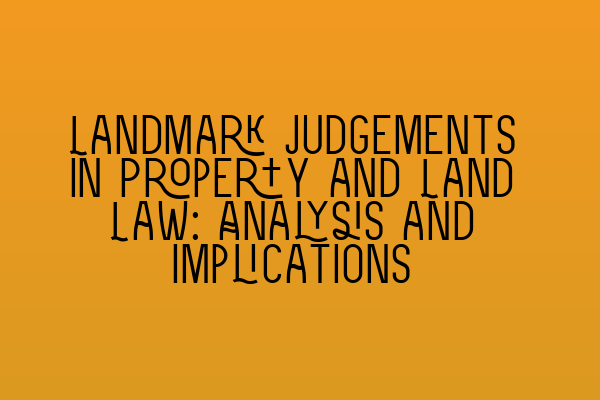Landmark Judgements in Property and Land Law: Analysis and Implications
In the ever-evolving field of property and land law, there have been several landmark judgements that have had a significant impact on the legal landscape. These judgements have shaped the way property rights are understood, boundaries are determined, and disputes are resolved. In this article, we will analyze some of the most influential cases and explore their implications on property and land law.
1. Understanding Contractual Capacity: Rights and Limitations
One of the landmark cases that had far-reaching implications in property law is the case of Donoghue v. Stevenson (1932). This case established the principle of negligence, which holds that individuals owe a duty of care to others. In the context of property and land law, this judgement has been utilized to determine the liability of property owners for injuries caused by dangerous conditions on their premises.
The judgement in Kelsen v. Imperial Tobacco Co. (1957) is another important case that established the doctrine of proprietary estoppel. This doctrine recognizes that individuals can acquire rights in property based on promises or assurances made to them by the property owner. This case has had implications on land disputes, particularly in situations where individuals have made improvements to property, relying on the promises of the owner.
2. Interactive SQE Mock Tests for Contract Law: Test Your Knowledge
Boundary disputes are a common source of conflict in property and land law. The case of Pye v. Graham (2002) dealt with the issue of adverse possession, where a person acquires title to land by openly using it without the permission of the legal owner for a specified period of time. This judgement clarified the requirements for establishing adverse possession and has had implications on property owners’ rights and disputes over boundaries.
Another significant case that has shaped property and land law is Street v. Mountford (1985). This case determined that the true nature of a tenancy agreement should be determined by its substance rather than its form. This judgement has had implications on the classification of tenancy agreements and the rights and obligations of landlords and tenants.
3. Join Our SQE Contract Law Webinars: Expert Insights and Guidance
One of the most contentious issues in property and land law is the determination of easements. Easements are rights that allow one party to use another party’s land for a specific purpose. The case of Re Ellenborough Park (1956) clarified the requirements for establishing an easement, including the necessity of the right being capable of being the subject of grant and being of benefit to the dominant land. This judgement has had implications on disputes over rights of way, rights to light, and other easements.
The case of Anchor Brewhouse Developments Ltd v. Berkley House (Docklands Developments) Ltd (1987) is another important judgement in property and land law. This judgement determined that a practical benefit must be derived from the proposed use of land in order for planning permission to be granted. This case has had implications on the process of obtaining planning permission and the development of land.
4. Contract Law Reforms: An Analysis of Recent Changes
Finally, the case of Birmingham Midshires Mortgage Services Ltd v. Sabherwal (2000) explored the issue of mortgage fraud and its implications for property and land law. This judgement clarified the responsibility of mortgage lenders to verify the authenticity of mortgage applications and has had implications on the rights and responsibilities of both lenders and borrowers in mortgage transactions.
In conclusion, these landmark judgements have had a profound impact on property and land law. They have shaped the legal principles and doctrines that govern property rights, boundaries, tenancy agreements, easements, planning permission, and mortgage transactions. Understanding these cases and their implications is crucial for legal professionals practicing in the field of property and land law.
For further reading on related topics, you may find the following articles helpful:
– Parties in a Contract: Rights and Responsibilities
We hope you enjoyed this analysis of landmark judgements in property and land law. If you have any questions or would like further information, please do not hesitate to contact us at SQE Property Law & Land Law.
